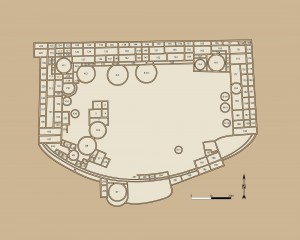Chaco Sites
Pueblo Alto
Site Description:
Pueblo Alto, Spanish for “high town,” is one of two Chacoan great houses on the mesa north of the canyon, approximately 0.6 miles (1.0 km.) from Pueblo Bonito. Pueblo Alto also is sometimes referred to as “Old Alto” to differentiate it from its neighbor – “New Alto.”
Pueblo Alto contains about 130 masonry rooms and 18 kivas; the roomblocks appear to have been single-story throughout. Unlike most other great houses of the same time, Pueblo Alto does not appear to have a great kiva. Initial construction of this classic D-shaped great house occurred about A.D. 1020, with additions and renovations continuing into the late 1000s. The front arc of rooms enclosing the plaza likely was added in the early 1100s. A large trash mound lies 150 feet (46 m.) southeast of the pueblo. A low masonry wall connects Pueblo Alto to the nearby great house of New Alto. The site was partially excavated by the National Park Service’s Chaco Project, primarily from 1976 to 1978, by Thomas Windes, Peter McKenna, Wolky Toll, and several other Chaco Project archaeologists. The undertaking included trenching the refuse mound which also had been examined in 1927 by Frank Roberts Jr. as part of his effort to identify the sequence of pottery types used by Chacoans through time.
Pueblo Alto’s mesa-top location allows for possible communications with other elevated great houses–Una Vida, Tsin Kletsin, and Peñasco Blanco–that can be seen from Alto. Pueblo Alto also was connected to several Chacoan roads from the north, including the Great North Road. Several of these roads converge on an opening in a wall that extends from the northeast corner of the great house, while another roadway passed just west of the building (Vivian and Hilpert 2002). Some have argued that the trash mound is largely a product of numerous ritual pilgrimages to the canyon by inhabitants of the San Juan Basin. A recent study by Wirt Wills (2001) does not support that interpretation.
Other site numbers for the great house are 29SJ389, LA 661, and Bc 251. The great house is also sometimes identified as “gambler’s house” in Navajo oral traditions.
Excavation History
- 1975-1979: Excavated by the Chaco Project under the direction of Thomas C. Windes, Peter McKenna, and Wolky Toll
Size and Dates
- 120 masonry rooms and 18 kivas
- Constructed between A.D. 1020 and the early 12th century.
Site and Room Data
- Aztec West Ruins
- Bc 50 - Tseh So
- Bc 51
- Bc 53 - Roberts' Site
- Bc 57
- Bc 58
- Bc 59
- Chetro Ketl
- Pueblo Bonito
- Pueblo del Arroyo
- Shabik'eshchee
- Talus Unit #1


